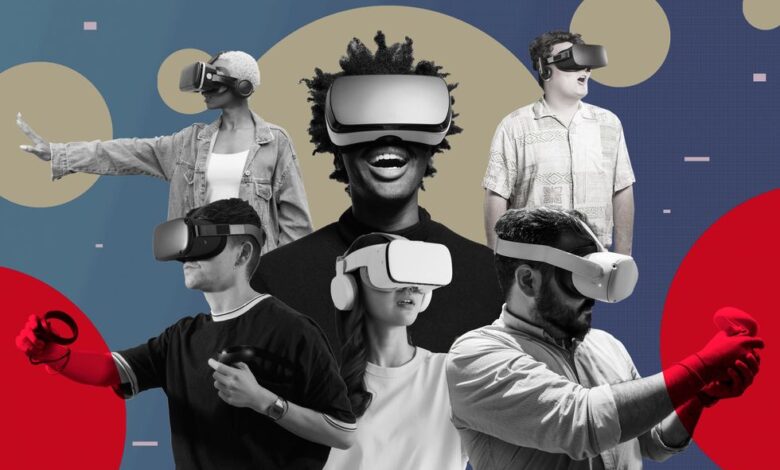Where VR Gaming Took a Wrong Turn

In 2017 Mark Zuckerberg stated a bold goal: He wanted
one billion people to try virtual reality (VR) by 2027. While he still has a few years to pull it off, the target remains impossibly farfetched. The most recent estimates place total worldwide VR headset sales at only 34 million.
VR Gaming was expected to lead this uptake, but why hasn’t it? We believe that VR gaming has been held back by game developers who are committed to a fantasy. In this fantasy, VR games align with the values of “hardcore” gamer culture, with advanced graphics and wholly immersive play. Aspirational attempts to reach this flawed fantasy have squashed the true potential of VR for gaming.
VR Gaming’s Contemporary Emergence
The 1990s and 2000s saw several ill-fated attempts to launch VR gaming systems—including the
Sega VR system, which the company promoted breathlessly but then never released, because it gave players motion sickness and headaches. But VR gaming’s contemporary emergence really began in August 2009, when then-17-year-old Palmer Luckey began posting on a VR enthusiasts forum about his plan to make a head-mounted VR gaming device. One early reader of Luckey’s posts was John Carmack, lead programmer for several of the most influential first-person shooter games, including Doom and Wolfenstein.
Palmer Luckey, shown here in 2013 at the age of 20, holds an early Oculus Rift virtual reality head-mounted display.Allen J. Schaben/Los Angeles Times/Getty Images
While working on the remaster of
Doom 3—which included support for 3D displays—Carmack was experimenting with different VR headsets that were available at the time. The two connected through their forum posts, and Luckey sent one of his prototype VR headsets to Carmack. When Carmack took the prototype to the major gaming expo E3 in 2012, it catalyzed an avalanche of interest in the project.
Carmack’s involvement put Luckey’s newly formed company,
Oculus VR, on a trajectory towards a particular kind of gaming: the hyper-violent games with high-fidelity graphics that hardcore gamers revere. Carmack, far beyond anyone else, pioneered the genre of hardcore games with his first-person shooter games.
Sega Visions Magazine promoted Sega VR in its August/September 1993 issue. Sega
Here’s how the gaming scholar
Shira Chess sums up the genre: “Traditionally, ‘hardcore’ describes games that are difficult to learn, expensive, and unforgiving of mistakes and that must be played over longer periods of time. Conversely, casual games can be learned quickly, are forgiving of mistakes and cheap or free, and can be played for either longer or shorter periods of time, depending on one’s schedule.”
Oculus’s
Kickstarter campaign in 2012 was proudly “designed for gamers, by gamers.” Soon after, Meta (then Facebook) acquired Oculus for US $3 billion in March 2014. The acquisition enraged many of those in the gaming community and those who had backed the original Kickstarter. Facebook was already an unpopular platform with the tech-enthusiast community, associated more closely with data collection and surveillance than gaming. If Facebook was associated with gaming, it was with casual social media games like Farmville and Bejeweled. But as it turns out, Meta went on to invest billions in VR, a level of investment highly unlikely if Oculus had remained independent.
The Three Wrong Assumptions of VR Gaming
VR’s origin in hardcore gaming culture resulted in VR game development being underpinned by three false assumptions about the types of experiences that would (or could) make VR gaming successful. These assumptions were that gamers wanted graphical realism and fast-paced violence, and that they didn’t want casual play experiences.
Over the past three decades, “AAA” game development—a term used in the games industry to signify high-budget games distributed by large publishers—has driven the massive expansion of computing power in consumer gaming devices. Particularly in PC gaming, part of what made a game hardcore was the computing power needed to run it at “maximum settings,” with the most detailed and textured graphics available.
The enormous advances in game graphics over the past 30 years contributed to significant improvements in player experience. This graphical realism became closely entwined with the concept of immersion.
For VR—which sold itself as “
truly immersive”—this meant that hardcore gamers expected graphically real VR experiences. But VR environments need to be rendered smoothly in order to not cause motion sickness, something made harder by a commitment to graphical realism. This aspiration saddling VR games with a nearly impossible compute burden.
One game that sidesteps this issue—and has subsequently become one of the most celebrated VR games—is
Superhot VR, an action puzzle with basic graphics in which enemy avatars and their bullets only move when the player moves their body.
The video game Superhot VR remains one of the top-selling VR games years after its release due to its unique experience of time manipulation through body movements.Superhot VR
Play begins with the player surrounded by attacking enemies, with death immediately returning the player to the starting moment. Play thus involves discovering what sequence of movements and attacks can get the player out of this perilous situation. It’s a learning curve reminiscent of the 2014 science-fiction film
Edge of Tomorrow, in which a hapless soldier (played by Tom Cruise) quicky becomes an elite, superhuman soldier while stuck in a time loop.
The attention in
Superhot’s gameplay is not to visual fidelity or sensory immersion, but what genuinely makes VR distinct: embodiment. The effect of its conceit is a superhuman-like control of time manipulation, with players deftly contorting their bodies to evade slow moving bullets while dispatching enemies with an empowering ease. Superhot VR provides an experience worth donning a headset for, and it consequently remains one of VR gaming’s top selling titles eight years after its release.
When Immersion Is Too Much
John Carmack’
Doom and Wolfenstein, on which VR’s gaming fantasy was based, are first-person shooters that closely map to hardcore gaming ideals. They’re hyperviolent, fast-paced, and difficult; they have a limited focus on story; and they feature some of the goriest scenes in games. In the same way that VR gaming has been detrimentally entwined with the pursuit of photorealism, VR gaming has been co-opted by these hardcore values that ultimately limit the medium. They lack mainstream appeal and valorise experiences that simply aren’t as appealing in VR as it is in a flat screen.
In a discussion around the design of
Half Life: Alyx—one of the only high-budget VR-only games—designers Greg Coomer and Robin Walker explain that VR changes the way that people interact with virtual environments. As Coomer says, “people are slower to traverse space, and they want to slow down and be more interactive with more things in each environment. It has affected, on a fundamental level, how we’ve constructed environments and put things together.” Walker adds that the changes aren’t “because of some constraint around how they move through the world, it’s just because they pay so much more attention to things and poke at things.” Environments in VR games are much denser; on PC they feel small, but in VR they feel big.
This in part explains why few games originally designed for flat screens and “ported” to VR have been successful. The rapidly paced hyperviolence best characterized by
Doom is simply sensory overload in VR, and the “intensity of being there”—one of Carmack’s aspirations—is unappealing. In VR, unrelenting games are unpleasurable: Most of us aren’t that coordinated, and we can’t play for extended periods of time in VR. It’s physically exhausting.
Casual Virtual Reality?
Beat Saber is a prime example of a game that might be derided as casual, if it weren’t the bestselling VR game of all time. Beat Saber is a music rhythm-matching game, a hybrid of Dance Dance Revolution, Guitar Hero, and Fruit Ninja. In time with electronic music, a playlist of red or blue boxes streams towards the player. Armed with two neon swords—commonly described as light sabers—the player must strike these boxes in the correct direction, denoted by a subtle white arrow.
Striking a box releases a note in the accompanying song, resulting in an experience that is half playing an instrument, and half dance. Well patterned songs create sweeping movements and rhythms reminiscent of the exaggerated gestures used by Nintendo Wii players.
Beat Saber
youtube
Beat Saber’s appeal is immersion-through-embodiment, also achieved by disregarding VR’s gaming fantasy of hardcore experiences. With each song being, well, song length, Beat Saber supports a shorter, casual mode of engagement that isn’t pleasurable because it is difficult or competitive, but simply because playing a song feels good.
Gaming in VR has been subjected to a vicious self-reinforcing cycle wherein VR developers create hardcore games, which appeal to a certain kind of hardcore gamer user, whose purchasing habits in turn drive further development of those kinds of games, and not others. Attempts to penetrate this feedback loop have been met with the
hostility of VR’s online gaming culture, appropriated from gamer culture at large.
As a result, the scope of VR games remains narrow, and oblivious to the kinds of games that might take VR to its billionth user. Maybe then, the one thing that could save VR gaming is the one possibility that VR enthusiasts decried the most when Facebook purchased Oculus in 2014:
Farmville VR.
IEEE Spectrum



